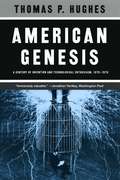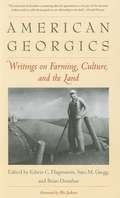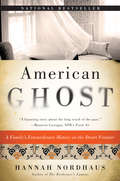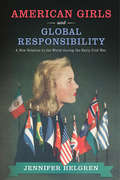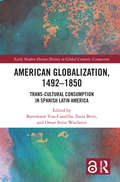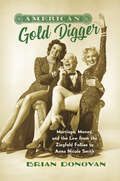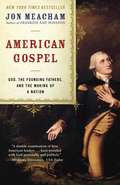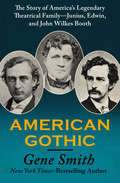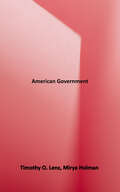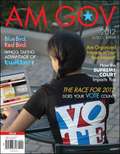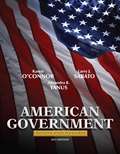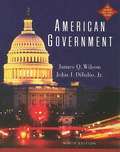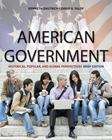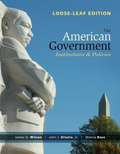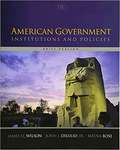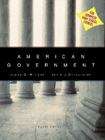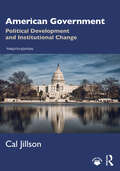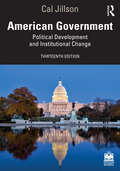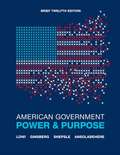- Table View
- List View
American Genesis: A Century of Invention and Technological Enthusiasm, 1870–1970
by Thomas P. HughesThe book that helped earn Thomas P. Hughes his reputation as one of the foremost historians of technology of our age and a finalist for the Pulitzer Prize in 1990, American Genesis tells the sweeping story of America's technological revolution. Unlike other histories of technology, which focus on particular inventions like the light bulb or the automobile, American Genesis makes these inventions characters in a broad chronicle, both shaped by and shaping a culture. By weaving scientific and technological advancement into other cultural trends, Hughes demonstrates here the myriad ways in which the two are inexorably linked, and in a new preface, he recounts his earlier missteps in predicting the future of technology and follows its move into the information age.
American Georgics: Writings on Farming, Culture, and the Land
by Sara M. Gregg Edwin C. Hagenstein Brian DonahueDrawing inspiration from Virgil's agrarian epic poem, Georgics, this collection presents a complex historical portrait of the American character through its relationship to the land.
American Ghost: A Family's Extraordinary History on the Desert Frontier
by Hannah NordhausAmerican Ghost is a “gripping mystery, moving family confessional, and chilling ghost story” (New York Times bestselling author Karen Abbott).“Journalist Hannah Nordhaus braids personal memoir with historical research and resolute ghost hunting in a narrative that investigates the restless spirit of her great-great-grandmother Julia Schuster Staab.” —Boston GlobeLa Posada—“place of rest”—was once a grand Santa Fe mansion. It belonged to Abraham and Julia Staab, who emigrated from Germany in the mid-nineteenth century. After they died, the house became a hotel. And in the 1970s, the hotel acquired a resident ghost—a sad, dark-eyed woman in a long gown. Strange things began to happen there: vases moved, glasses flew, blankets were ripped from beds. Julia Staab died in 1896—but her ghost, they say, lives on.In American Ghost, Julia’s great-great-granddaughter, Hannah Nordhaus, traces her ancestor’s transfiguration from nineteenth-century Jewish bride to modern phantom. Family diaries, photographs, and newspaper clippings take her on a riveting journey through three hundred years of German history and the American immigrant experience. With the help of historians, genealogists, family members, and ghost hunters, she weaves a masterful, moving story of fin-de-siècle Europe and pioneer life, villains and visionaries, medicine and spiritualism, imagination and truth, exploring how lives become legends, and what those legends tell us about who we are.“A haunting story about the long reach of the past.” —Maureen Corrigan, NPR’S Fresh Air“In this intriguing book, [Nordhaus] shares her journey to discover who her immigrant ancestor really was—and what strange alchemy made the idea of her linger long after she was gone.” —People
American Girls and Global Responsibility: A New Relation to the World during the Early Cold War
by Jennifer HelgrenAmerican Girls and Global Responsibility brings together insights from Cold War culture studies, girls’ studies, and the history of gender and militarization to shed new light on how age and gender work together to form categories of citizenship. Jennifer Helgren argues that a new internationalist girl citizenship took root in the country in the years following World War II in youth organizations such as Camp Fire Girls, Girl Scouts, YWCA Y-Teens, schools, and even magazines like Seventeen. She shows the particular ways that girls’ identities and roles were configured, and reveals the links between internationalist youth culture, mainstream U.S. educational goals, and the U.S. government in creating and marketing that internationalist girl, thus shaping the girls’ sense of responsibilities as citizens.
American Girls in Red Russia: Chasing the Soviet Dream
by Julia L. MickenbergIf you were an independent, adventurous, liberated American woman in the 1920s or 1930s where might you have sought escape from the constraints and compromises of bourgeois living? Paris and the Left Bank quickly come to mind. But would you have ever thought of Russia and the wilds of Siberia? This choice was not as unusual as it seems now. As Julia L. Mickenberg uncovers in American Girls in Red Russia, there is a forgotten counterpoint to the story of the Lost Generation: beginning in the late nineteenth century, Russian revolutionary ideology attracted many women, including suffragists, reformers, educators, journalists, and artists, as well as curious travelers. Some were famous, like Isadora Duncan or Lillian Hellman; some were committed radicals, though more were just intrigued by the “Soviet experiment.” But all came to Russia in search of social arrangements that would be more equitable, just, and satisfying. And most in the end were disillusioned, some by the mundane realities, others by horrifying truths. Mickenberg reveals the complex motives that drew American women to Russia as they sought models for a revolutionary new era in which women would be not merely independent of men, but also equal builders of a new society. Soviet women, after all, earned the right to vote in 1917, and they also had abortion rights, property rights, the right to divorce, maternity benefits, and state-supported childcare. Even women from Soviet national minorities—many recently unveiled—became public figures, as African American and Jewish women noted. Yet as Mickenberg’s collective biography shows, Russia turned out to be as much a grim commune as a utopia of freedom, replete with economic, social, and sexual inequities. American Girls in Red Russia recounts the experiences of women who saved starving children from the Russian famine, worked on rural communes in Siberia, wrote for Moscow or New York newspapers, or performed on Soviet stages. Mickenberg finally tells these forgotten stories, full of hope and grave disappointments.
American Globalization, 1492–1850: Trans-Cultural Consumption in Spanish Latin America (Early Modern Iberian History in Global Contexts)
by Bartolomé Yun-Casalilla; Ilaria Berti; Omar Svriz-WuchererFollowing a study on the world flows of American products during early globalization, here the authors examine the reverse process. By analyzing the imperial political economy, the introduction, adaptation and rejection of new food products in America, as well as of other European, Asian and African goods, American Globalization, 1492–1850, addresses the history of consumerism and material culture in the New World, while also considering the perspective of the history of ecological globalization. This book shows how these changes triggered the formation of mixed imagined communities as well as of local and regional markets that gradually became part of a global economy. But it also highlights how these forces produced a multifaceted landscape full of contrasts and recognizes the plurality of the actors involved in cultural transfers, in which trade, persuasion and violence were entwined. The result is a model of the rise of consumerism that is very different from the ones normally used to understand the European cases, as well as a more nuanced vision of the effects of ecological imperialism, which was, moreover, the base for the development of unsustainable capitalism still present today in Latin America.
American Gold Digger: Marriage, Money, and the Law from the Ziegfeld Follies to Anna Nicole Smith (Gender and American Culture)
by Brian DonovanThe stereotype of the "gold digger" has had a fascinating trajectory in twentieth-century America, from tales of greedy flapper-era chorus girls to tabloid coverage of Anna Nicole Smith and her octogenarian tycoon husband. The term entered American vernacular in the 1910s as women began to assert greater power over courtship, marriage, and finances, threatening men's control of legal and economic structures. Over the course of the century, the gold digger stereotype reappeared as women pressed for further control over love, sex, and money while laws failed to keep pace with such realignments. The gold digger can be seen in silent films, vaudeville jokes, hip hop lyrics, and reality television. Whether feared, admired, or desired, the figure of the gold digger appears almost everywhere gender, sexuality, class, and race collide.This fascinating interdisciplinary work reveals the assumptions and disputes around women's sexual agency in American life, shedding new light on the cultural and legal forces underpinning romantic, sexual, and marital relationships.
American Gospel: God, the Founding Fathers, and the Making of a Nation
by Jon MeachamThe American Gospel–literally, the good news about America–is that religion shapes our public life without controlling it. In this vivid book, New York Times bestselling author Jon Meacham tells the human story of how the Founding Fathers viewed faith, and how they ultimately created a nation in which belief in God is a matter of choice.At a time when our country seems divided by extremism, American Gospel draws on the past to offer a new perspective. Meacham re-creates the fascinating history of a nation grappling with religion and politics–from John Winthrop’s “city on a hill” sermon to Thomas Jefferson’s Declaration of Independence; from the Revolution to the Civil War; from a proposed nineteenth-century Christian Amendment to the Constitution to Martin Luther King, Jr.’s call for civil rights; from George Washington to Ronald Reagan.Debates about religion and politics are often more divisive than illuminating. Secularists point to a “wall of separation between church and state,” while many conservatives act as though the Founding Fathers were apostles in knee britches. As Meacham shows in this brisk narrative, neither extreme has it right. At the heart of the American experiment lies the God of what Benjamin Franklin called “public religion,” a God who invests all human beings with inalienable rights while protecting private religion from government interference. It is a great American balancing act, and it has served us well.Meacham has written and spoken extensively about religion and politics, and he brings historical authority and a sense of hope to the issue. American Gospel makes it compellingly clear that the nation’s best chance of summoning what Lincoln called “the better angels of our nature” lies in recovering the spirit and sense of the Founding. In looking back, we may find the light to lead us forward.
American Gothic: The Story of America's Legendary Theatrical Family—Junius, Edwin, and John Wilkes Booth
by Gene SmithA New York Times–bestselling author&’s &“lively&” account of a family of famous actors—who became notorious after the assassination of President Lincoln (The New Yorker). Junius Booth and his sons, Edwin and John Wilkes, were nineteenth-century America&’s most famous theatrical family. Yet the Booth name is forever etched in the history books for one terrible reason: the assassination of President Abraham Lincoln by John Wilkes Booth at Ford&’s Theatre on April 14, 1865. In American Gothic, bestselling historian Gene Smith vividly chronicles the triumphs, scandals, and tragedies of this infamous family. The preeminent English tragedian of his day, Junius Booth was a madman and an alcoholic who abandoned his wife and young son to move to America and start a new family. His son Edwin became the most renowned Shakespearean actor in America, famously playing Hamlet for one hundred consecutive nights, but he suffered from depression and a crippling fear of inheriting his father&’s insanity. Blessed with extraordinary good looks and a gregarious nature, John Wilkes Booth seemed destined for spectacular fame and fortune. However, his sympathy for the Confederate cause unleashed a dangerous instability that brought permanent disgrace to his family and forever changed the course of American history. Richly detailed and emotionally insightful, American Gothic is a &“ripping good tale&” that brings to life the true story behind a family tragedy of Shakespearean proportions (The New York Times).
American Government
by Mirya Holman Timothy O. LenzUniversity of West Georgia American Government book
American Government 2012
by McGraw-HillPublished annually at the start of each year,Am Govprovides unmatched currency and is the first student-centered American Government text. It provides instructors who normally choose a big, brief, or essentials text with scholarly, succinct, and conventionally organized core content. A magazine format engages students and motivates active participation in our democracy (all this, and at a price that students prefer). Painstaking student and instructor reviews, surveys, and focus groups; as well as ethnographic research into student study behaviors, preferences, and needs, makeAm Govthe product of serious scholarship. Am Govbrings serious fun to American Government through its quality, currency, features, and format.
American Government Pacemaker (3rd Edition)
by Jane PetlinksiThis book will give you a basic understanding of the system of government of the United States. First you will learn about the roots of the government. You will discover that the United States system reflects some principles of government that are thousands of years old. Then you will learn how federal, state, and local governments work, independently and cooperatively, for the good of all citizens. Perhaps most importantly, you will learn about the freedoms and rights guaranteed to all United States citizens.
American Government Roots and Reform (2011 National Edition)
by Larry J. Sabato Karen J. O'Connor Alixandra B. YanusUpdated in a new 2011 edition, American Government: Roots and Reform provides the historical context students need to understand our government and the most crucial and controversial issues affecting the nation in the 21st century. This bestselling book has been extensively revised to provide in-depth coverage of President Barrack Obama's first two years in office and the 111thCongress, the 2010 congressional elections, continued concerns related to the wars in Iraq and Afghanistan, and domestic concerns related to health care reform and the economy.
American Government in Christian Perspective (2nd edition)
by Michael R. Lowman William R. Bowen George T. Thompson George C. CochranThe United States is just a little over 200 years old, a mere child in relation to the 6,000 years of recorded human history. Yet, in just two centuries, the United States has excelled the world's most ancient civilizations to become the greatest nation on earth.
American Government, AP Version (9th Edition)
by James Q. Wilson John J. Dilulio Jr.For this edition we have included a new feature: Each chapter now ends with a section called "Reconsidering the Enduring Questions" that gives contemporary responses to the Enduring Questions with which each chapter begins. These brief essays should help students focus in a novel way on what many people think are the perennial puzzles of American politics.
American Government: Brief Version (8th edition)
by James Q. WilsonThe president gets elected because of some slick television ads, although he has ducked all the tough questions. His party's platform is a meaningless set of words that gives you no idea what he will do in office. Once in the White House. He proposes bill and then Congress decides which to pass.
American Government: Freedom, Rights, Responsibilities
by Vivian BernsteinAmerican Government tells the story of how our government came to be. You will learn about all the branches of the government and their many jobs and see how leaders are elected, and how people can make a difference. You will learn about the role our government plays as one nation among many, and see that your government is "of the people, by the people, for the people." The book has two important pieces of writing-the Declaration of Independence and the Constitution of the United States.
American Government: Historical, Popular, and Global Perspectives (Brief Edition)
by Kenneth Dautrich David YalofGenerating thoughtful discussion can be a challenge with today's sometimes politically indifferent students. The authors of AMERICAN GOVERNMENT: HISTORICAL, POPULAR, & GLOBAL PERSPECTIVES tackle this issue with a streamlined and visually appealing version of their more comprehensive text that helps you create a lively, engaging classroom. Well-organized and easy to understand, this brief edition is a handy, less expensive paperback your students will refer to long after completing your course.
American Government: Institutions And Policies
by James Q. Wilson John J. Diiulio Meena BoseAcclaimed for the scholarship of its prominent authors and the clarity of its narrative, AMERICAN GOVERNMENT: INSTITUTIONS AND POLICIES sets the standard for public policy coverage while maintaining focus on three fundamental topics: the institutions of American government; the historical development of governmental procedures, actors, and policies; and who governs in the United States and to what ends. Reader involvement in the material is bolstered by features such as learning objectives, Constitutional Connections relating current issues to founding principles, and How Things Work boxes that illustrate important concepts. Available separately, a state-of-the-art media package with online tools makes the learning experience engaging and accessible.
American Government: Institutions And Policies
by James Q. Wilson John J. Dilulio Meena BoseThorough yet concise, this popular brief book emphasizes the historical development of the American political system, who governs, and to what ends. The twelfth edition of AMERICAN GOVERNMENT: INSTITUTIONS AND POLICIES, BRIEF VERSION, offers coverage of the 2014 campaigns and elections; budget battles and the sequestration of funds; ongoing debates about immigration, gay marriage, and other key issues in American politics; and foreign-policy decisions on Afghanistan, the Middle East, and North Korea.
American Government: Institutions and Policies (8th, Post-9/11 Edition)
by James Q. Wilson John J. DilulioIn preparing this edition, the authors have taken a look at how the book has grown in recent years and have tried to cut its length judiciously, without sacrificing any important content. They have also been alert to some major issues that have come to influence politics, analyzing some extensively and minimizing a few that, in retrospect, seem less important.
American Government: Political Development and Institutional Change
by Cal JillsonHow politics in America works today, how it got that way, and how it’s likely to change through reform—these are the themes that pervade every chapter of Cal Jillson’s highly lauded American Government: Political Development and Institutional Change. Even in the midst of current challenges, America’s past is present in all aspects of the contemporary political system. Jillson uses political development and the dynamics of change as a thematic tool to help students understand how politics works now—and how institutions, participation, and policies have evolved over time to produce the contemporary political environment. In addition, Jillson helps students think critically about how American democracy might evolve further, focusing in every chapter on reform and further change. New to the 12th Edition: Assesses the characteristics and results of the Trump administration and the policy and tonal changes of the early Biden adminstration. Describes numerous ways in which the American political system has been affected by the Covid-19 pandemic Assesses the implications of the January 6, 2021 attack on the Capitol and what it implies for our political culture and partisan politics. Assesses the implication of "fake news" and "the move to mobile" for our politics. Explores the evidence for increasing polarization in public opinion, voting behavior, and the work of Congress and the courts.. Details the impact that the Russian invasion of Ukraine had on President Biden’s attempt to rebuild U.S. national security alliances.
American Government: Political Development and Institutional Change
by Cal JillsonHow politics in America works today, how it got that way, and how it’s likely to change through reform—these are the themes that pervade every chapter of Cal Jillson’s highly lauded American Government: Political Development and Institutional Change. Even in the midst of current challenges, America’s past is present in all aspects of the contemporary political system. Jillson uses political development and the dynamics of change as a thematic tool to help students understand how politics works now—and how institutions, participation, and policies have evolved over time to produce the contemporary political environment. In addition, Jillson helps students think critically about how American democracy might evolve further, focusing in every chapter on reform and further change.New to the Thirteeenth Edition Assesses the results of the Biden administration and the impact on the 2024 campaign of Biden’s unexpected replacement by Kamala Harris at the top of the ticket. Describes numerous ways in which the American political system has been affected by recovery from the Covid-19 pandemic, the demise of Roe v. Wade, inflation, and the border. Assesses the implications of the January 6, 2021 attack on the Capitol, the Trump trials, and what they mean for our political culture and partisan politics. Assesses the implication of "fake news" and "the move to mobile" for our politics.Explores the evidence for increasing polarization in public opinion, voting behavior, and the work of Congress and the courts. Details the impact that the Russian invasion of Ukraine and the war in Israel and Gaza had on U.S. foreign policy and national security alliances.
American Government: Power and Purpose (Brief 12th Edition)
by Benjamin Ginsberg Stephen Ansolabehere Theodore J. Lowi Kenneth A. ShepsleBased on the Full Edition of American Government: Power and Purpose but with a simpler framework, the Brief Edition combines authoritative, concise coverage of the central topics in American politics with smart pedagogical features designed to get students thinking analytically. The Twelfth Edition has been extensively revised by new co-author Stephen Ansolabehere and updated with new pedagogy.
